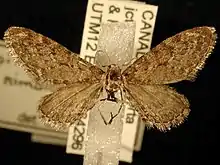Eupithecia nimbicolor
Eupithecia nimbicolor is a moth in the family Geometridae first described by George Duryea Hulst in 1896.[1][2] It is found in North America from eastern Newfoundland and Labrador to western British Columbia and from Alaska to Arizona.[3]
| Eupithecia nimbicolor | |
|---|---|
 | |
| Scientific classification | |
| Kingdom: | Animalia |
| Phylum: | Arthropoda |
| Class: | Insecta |
| Order: | Lepidoptera |
| Family: | Geometridae |
| Genus: | Eupithecia |
| Species: | E. nimbicolor |
| Binomial name | |
| Eupithecia nimbicolor (Hulst, 1896) | |
| Synonyms | |
| |
The wingspan is 17–23 mm. Adults are grey and yellow or orange brown suffused. Adults are on wing from mid-May to mid-July in the north.
The larvae feed on the flowers of Achillea and Castilleja species and the foliage of Salix, Rosa, Potentilla fruticosa and Ribes species.[4]
References
- Yu, Dicky Sick Ki. "Eupithecia nimbicolor (Hulst 1896)". Home of Ichneumonoidea. Taxapad. Archived from the original on March 24, 2016.
- "910366.00 – 7522 – Eupithecia nimbicolor – (Hulst, 1896)". North American Moth Photographers Group. Mississippi State University. Retrieved May 2, 2019.
- Rindge, Frederick H. (July 25, 1963). "Notes on and descriptions of North American Eupithecia (Lepidoptera, Geometridae)" (PDF). American Museum Novitates. 2147: 1–23.
- Anweiler, G. G. (2007). "Species Details: Eupithecia nimbicolor". University of Alberta Museums. E.H. Strickland Entomological Museum. Retrieved December 27, 2020.
| Wikimedia Commons has media related to Eupithecia nimbicolor. |
| Wikispecies has information related to Eupithecia nimbicolor. |
This article is issued from Wikipedia. The text is licensed under Creative Commons - Attribution - Sharealike. Additional terms may apply for the media files.